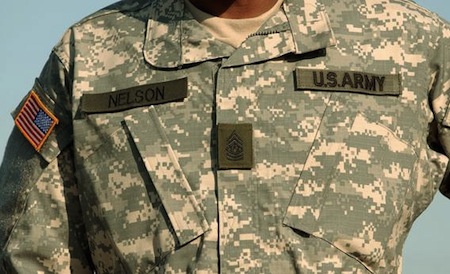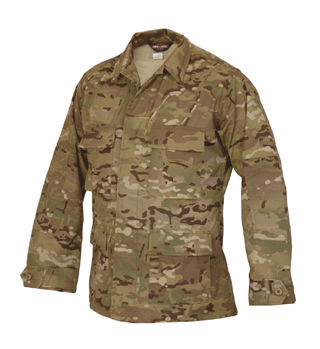Science Fiction
Dictionary
A B C D E F G H I J K L M N O P Q R S T U V W X Y Z
What Camouflage Pattern Is Best?

What is the best pattern for military camouflage? Military planners like the idea of one solution for all uses, as demonstrated in the pixelated Universal Camouflage Pattern (UCP) released in 2004. However, it was outperformed in the field by other designs.

(Universal Camouflage Pattern [UCP])
Pixelated camo prints, or at least the theory behind them, arrived long before the fashion craze. Their history begins with an experimental psychologist (and Jungian analyst) named Lt. Col. Timothy O'Neill. While teaching at West Point, O'Neill thought to apply new ideas about human perception to the art of the concealment. Neuroscientists had divided the human visual system into a pair of parallel circuits with different functions: One neural pathway alerts us to the presence of objects in the world (where is it?), while the other helps us figure out what those objects might be (what is it?).O'Neill figured that a smart camouflage would have to take account of both pathways, so he devised a pattern with two overlaid textures. At one level, a "micro-pattern" made of discrete color blocks would blend in with the visual noise in a scene and confound the where-is-it pathway. At a second level, those shapes would form a larger "macro-pattern," like the tree branches in a Seurat painting, meant to break up the symmetries of a target and flummox the brain's what-is-it neurons. In 1979, O'Neill's "DualTex" design was blotted onto the vehicles of the 2nd Armored Cavalry Regiment with square sponges, in the first major field test of digital camouflage.
The early results were promising, but it took another 20 years for the DualTex concept to worm its way into the collective unconscious of the Defense Department.
As good as the theory might be, testing showed that the UCP finished behind other designs, like the MultiCam pattern and another pattern called Desert Brush.
The US Army now seems to be standing behind MultiCam as the new standard.

(MultiCam pattern shirt)
The following video presents 70 different camouflage patterns used over the years; it covers camo patterns used by law enforcement as well as the military, in the USA and many other countries.
(Video shows 70 different camouflage patterns)
Science fiction writers have taken their best shot at the camouflage idea. For urban use, consider the mimetic polycarbon suit from the 1984 novel Neuromancer by William Gibson:
His body was nearly invisible, an abstract pattern approximating the scribbled brickwork sliding smoothly across his tight one piece.
Another creative possibility is the chameleon cloth from the 1977 novel Dying of the Light by George R.R. Martin:
They rode forward together, gaining altitude steadily... The chameleon cloth overalls they wore had gone all gray and white...
For more specialized uses, take a look at Camouflage To Confound Face Recognition and E-Camouflage - Invisible Tanks. Via Slate.
Scroll down for more stories in the same category. (Story submitted 7/6/2012)
Follow this kind of news @Technovelgy.| Email | RSS | Blog It | Stumble | del.icio.us | Digg | Reddit |
Would
you like to contribute a story tip?
It's easy:
Get the URL of the story, and the related sf author, and add
it here.
Comment/Join discussion ( 1 )
Related News Stories - (" Warfare ")
'Warrior Suit' Combat Exoskeleton Project Still Alive
'Suited up, you look like a big steel gorilla.'
Sea Drones Attack Russian Fleet
'...autofreighters, and other self-piloting craft.' - Ray Naylor, 2022.
Slaughterbot AI KIller Quadcopter Drones
'The real border was defended by... a swarm of quasi-independent aerostats.' - Neal Stephenson, 1995.
Russia Working On Military Exoskeletons
'...you look like a big steel gorilla...' - Robert Heinlein, 1959.
Technovelgy (that's tech-novel-gee!) is devoted to the creative science inventions and ideas of sf authors. Look for the Invention Category that interests you, the Glossary, the Invention Timeline, or see what's New.
Science Fiction
Timeline
1600-1899
1900-1939
1940's 1950's
1960's 1970's
1980's 1990's
2000's 2010's
Current News
Golf Ball Test Robot Wears Them Out
"The robot solemnly hit a ball against the wall, picked it up and teed it, hit it again, over and again...'
Boring Company Vegas Loop Like Asimov Said
'There was a wall ahead... It was riddled with holes that were the mouths of tunnels.'
Rigid Metallic Clothing From Science Fiction To You
'...support the interior human structure against Jupiterís pull.'
Is The Seattle Ultrasonics C-200 A Heinlein Vibroblade?
'It ain't a vibroblade. It's steel. Messy.'
Roborock Saros Z70 Is A Robot Vacuum With An Arm
'Anything larger than a BB shot it picked up and placed in a tray...'
A Beautiful Visualization Of Compact Food
'The German chemists have discovered how to supply the needed elements in compact, undiluted form...'
Bone-Building Drug Evenity Approved
'Compounds devised by the biochemists for the rapid building of bone...'
Secret Kill Switch Found In Yutong Buses
'The car faltered as the external command came to brake...'
Inmotion Electric Unicycle In Combat
'It is about the size and shape of a kitchen stool, gyro-stabilized...'
Grok Scores Best In Psychological Tests
'Try to find out how he ticks...'
PaXini Supersensitive Robot Fingers
'My fingers are not that sensitive...'
Congress Considers Automatic Emergency Braking, One Hundred Years Too Late
'The greatest problem of all was the elimination of the human element of braking together with its inevitable time lag.'
The Desert Ship Sailed In Imagination
'Across the ancient sea floor a dozen tall, blue-sailed Martian sand ships floated, like blue smoke.'
The Zapata Air Scooter Would Be Great In A Science Fiction Story
'Betty's slapdash style.'
Thermostabilized Wet Meat Product (NASA Prototype)
There are no orbiting Michelin stars. Yet.
Could Crystal Batteries Generate Power For Centuries?
'Power could be compressed thus into an inch-square cube of what looked like blue-white ice'
